The history of surfing: A surf evolution timeline
- Written by Emilia
- Published April 27, 2024
Post contents
Introduction
The most commonly recognized origin of surfing when it comes to the history of surfing is the ancient Polynesia, and more specifically Hawaii. Surfing had significant cultural and spiritual significance, and men and women of all ages and social classes surfed both for fun as well as competed.
Sadly, surfing nearly died out in Hawaii when it was colonized in the 18th Century and the majority of the native population died from diseases brought by Westerners, and surfing was shamed and discouraged by Christian missionaires.
In the late 19th Century and early 20th Century, surfing was brought back to life by Duke Kahanamoku among other influential Hawaiian surfers- both in Hawaii as well as outside of Hawaii.
Between the 1920s-1950s, amazing progress was done in the area of surfboard design, making surfboards better and more user-friendly. This led to surfing growing, and the number of women practicing surfing increased. What eventually had a significant boost on the popularity of surfing was the movie about the female surfer Kathy Kohner-Zuckerman called Gidget, released in 1959. With the release of Gidget, surfing was brought into popular culture and rose the popularity of surfing like crazy in the 1960s.
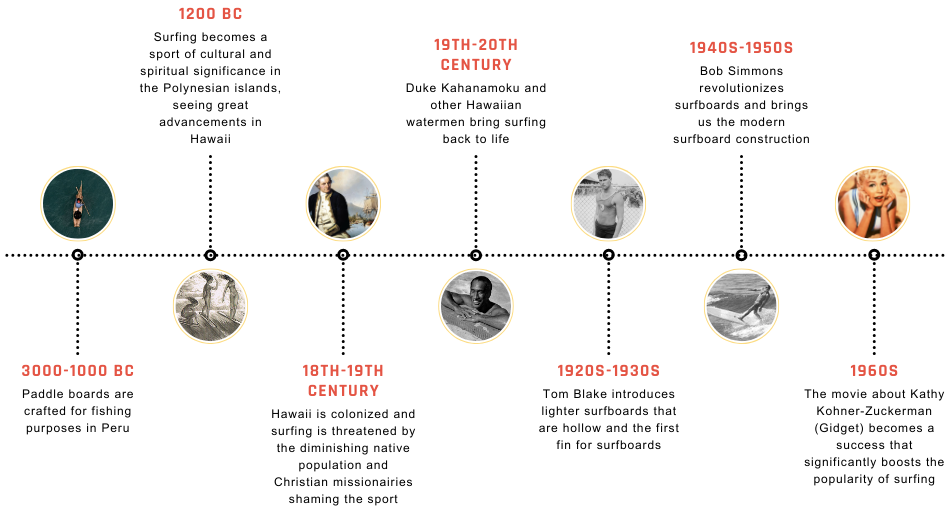
That’s a shortened summary for you- now, let’s explore the juicy details of these events!
A timeline of influential events in the history of surfing
There’s so much to say about the history of surfing, and so many factors and events that have shaped this sport. In this lesson, I have listed the most commonly known events in surfing history, providing a good foundational understanding of the history of surfing.
3000-1000 BC: Paddle boards are crafted for fishing purposes in Peru
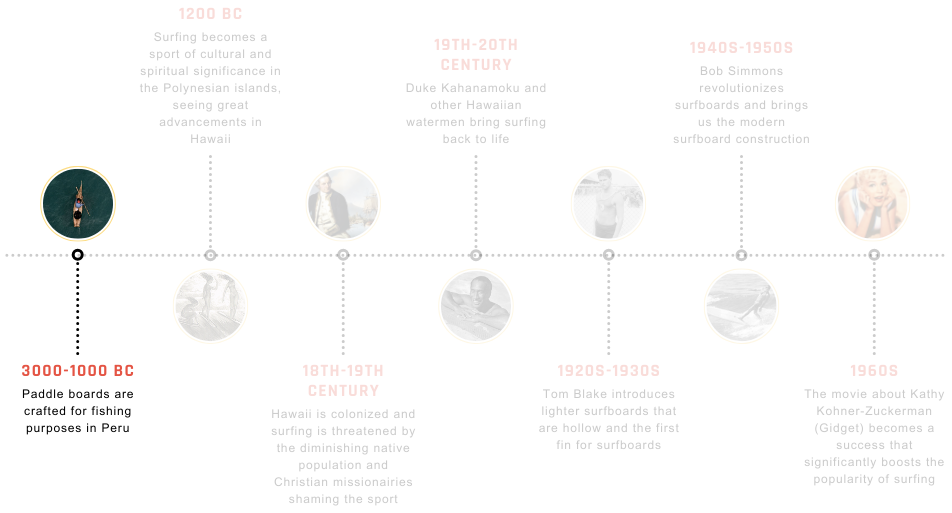
Some say that the origin of surfing goes back all the way to the ancient Peru. Back then, fishermen used a type of paddle board called Caballito de Totora (the ancient name of this craft is Tūp and the English name is Little Red Horse) for fishing, made from reed plants. They would ride these paddle boards back to shore, which according to some should be considered the first form of surfing.
The evidence of this paddle board-like vessel is archeological pottery sculpture finds sculpted as fishermen riding a Caballito de Totora.
1200 BC: Surfing becomes a sport of cultural and spiritual significance in the Polynesian islands, seeing great advancements in Hawaii
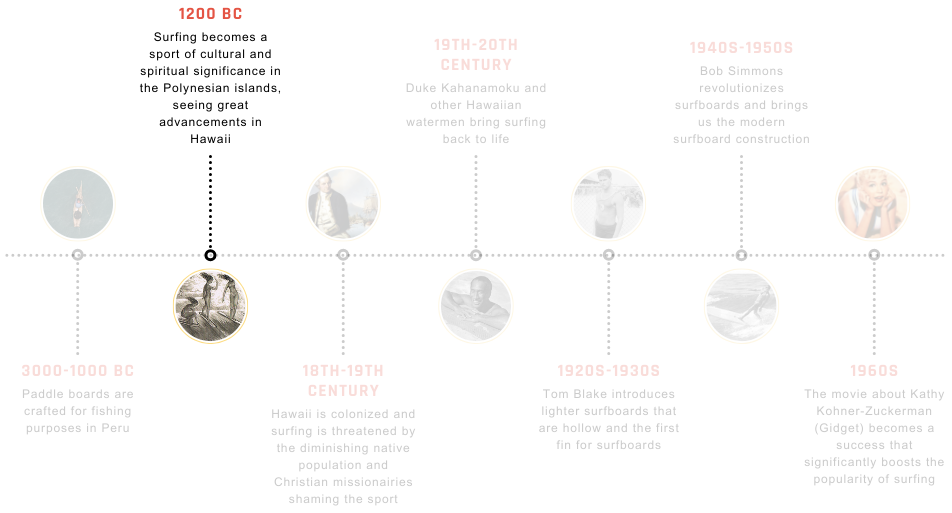
A more commonly known origin of surfing is the ancient Polynesia. Polynesia is a subregion of Oceania and comprises over 1,000 islands spread across the central and southern Pacific Ocean. While surfing was practiced across the Polynesian Pacific, it was in the Hawaiian islands, that are part of Polynesia, where the sport saw its greatest advancements.
Known as “he’e nalu” in Hawaiian, surfing was a sacred art form that held spiritual significance and cultural importance among the Polynesian people, with rituals and ceremonies dedicated to the sport. Surfers were admired for their skill and bravery, and surfing was often associated with chiefs, warriors, and spiritual leaders. Men and women of all ages and social classes surfed for fun as well as competed against each other, and certain surf spots were reserved for the best surfers.
Traditional Polynesian surfboards (called Olo in Hawaiian) were crafted from wood and did not have any fins, unlike today’s surfboards. Some evidence that surfing was performed in Polynesia already in the 12th Century is ancient cave paintings showing people surfing.
18th-19th Century: Hawaii is colonized and surfing is threatened by the diminishing native population and Christian missionairies shaming the sport
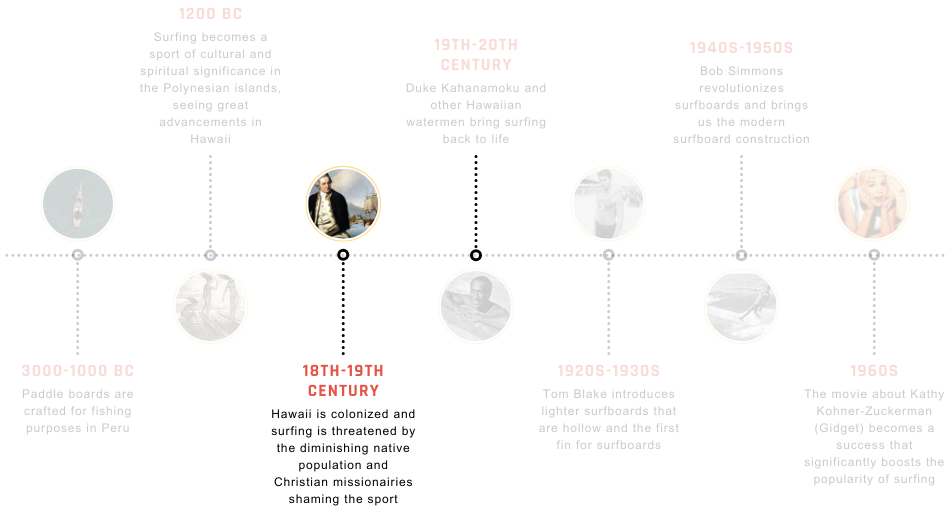
1778: British explorer Captain James Cooks discovers Hawaii
In 1778, Captain James Cook, the British explorer and navigator, is commonly recognized as the first European to discover Hawaii. The ship’s surgeon, Dr. William Anderson, documented a written description of surfing during the exploration, which was published in a book series called “A voyage to the Pacific Ocean” in 1784.
Captain Cook’s arrival in Hawaii altered the course of the islands forever. Following colonization, the lives of native Hawaiians deteriorated. Illnesses brought by Europeans and Americans greatly reduced Hawaii’s native population. By 1890, there were less than 40,000 Hawaiians left, down from possibly over 800,000 before the British discovery of Hawaii. This threat to the natives was also what became the biggest threat to surfing.
1820: The first missionaries arrive in Hawaii
Several decades after the colonization started, Christian missionairies from America called calvinists arrived in Hawaii. They regarded surfing as sinful, and shamed the natives into stopping surfing (along with other traditions of native culture). By the late 1880s, it is believed that there were only about 150 surfers remaining across the Hawaiian islands.
19th-20th Century: Duke Kahanamoku and other Hawaiian watermen bring surfing back to life
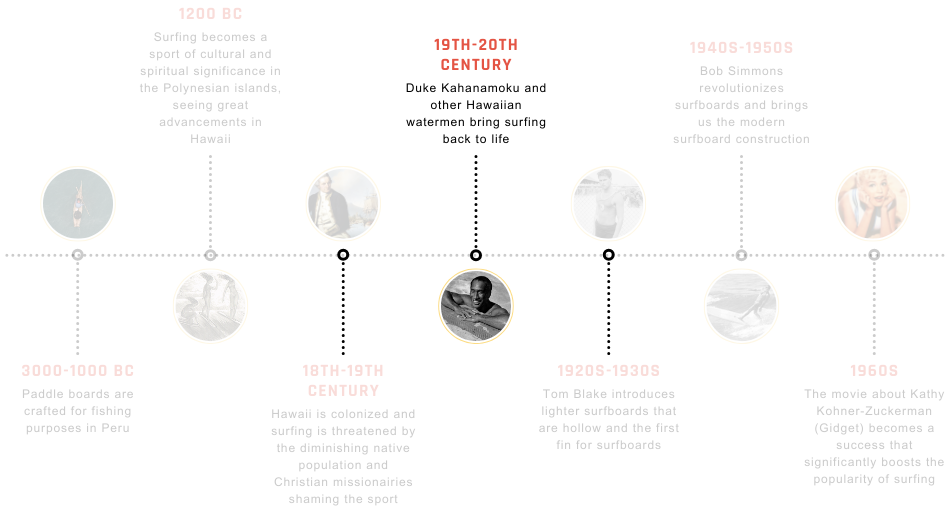
Despite nearly loosing the surfing tradition, in the late 19th Century and early 20th Century, there were three main factors that contributed to bringing surfing back to life. Let’s explore them!
1885: Three Hawaiian princes bring surfing to California during their studies
David Kawānanakoa, Jonah Kūhiō Kalaniana’ole and Edward Keli’ialonui were three Hawaiian royal brothers who in 1885 started studying at the prestigious military academy St. Matthews Hall in California.
In Santa Cruz, the three princes would spend their summers with friends of the royal family, where they would also go surfing with surfboards they had brought with them from Hawaii. Residents of Santa Cruz were fascinated by this unfamiliar activity, seeing the brothers gliding over the water’s surface.
1907: George Freeth works as a surf instructor in Waikiki and brings surfing to California
Another individual who greatly influenced the growth of surfing was George Freeth. As tourism began to thrive in Hawaii, Hawaiians recognized surfing as a valuable tourist attraction. George Freeth was an Irish-Hawaiian surfer employed at a hotel in Waikiki, where he taught guests how to surf.
In 1907 he moved to California and established himself as a key figure in the surfing community. While he wasn’t the first Hawaiian surfer in California, he played an important role in spreading surf stoke across the state and beyond, leaving a lasting legacy on the sport.
1914: Duke Kahanamoku "The Duke" brings surfing to Australia
George Freeth had a young friend named Duke Kahanamoku, also known as “The Duke,” who is perhaps the most famous figure in history for popularizing and modernizing surfing. Duke was a Hawaiian freestyle swimmer who won three gold medals in swimming during his Olympic career.
In 1914 he went to Australia to teach Australians his swimming technique as well as to teach Australians how to surf. He was already quite a super star in Australia before arriving, and he would have thousands of spectators.
1920s-1930s: Tom Blake introduces lighter surfboards that are hollow and the first fin for surfboards
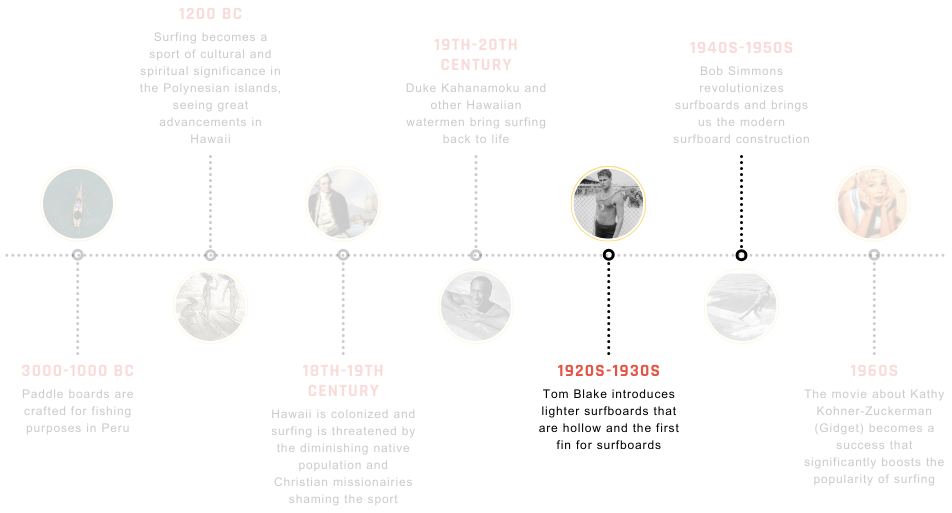
Tom Blake, a swimmer in the American swimming team and friend of Duke Kahanamoku, went to Hawaii in 1924. Although he had attempted surfing a few times back in California, Hawaii is where he elevated his surfing.
While in Hawaii, he became fascinated with the construction on surfboards and started experimenting with their construction. Tom revolutionized surfboards by introducing lighter, hollow surfboards and the first fin for surfboards, which greatly improved the manoeuvrability of surfboards. He gave us modern surfboard construction!
1940s-1950s: Bob Simmons revolutionizes surfboards and brings us the modern surfboard construction
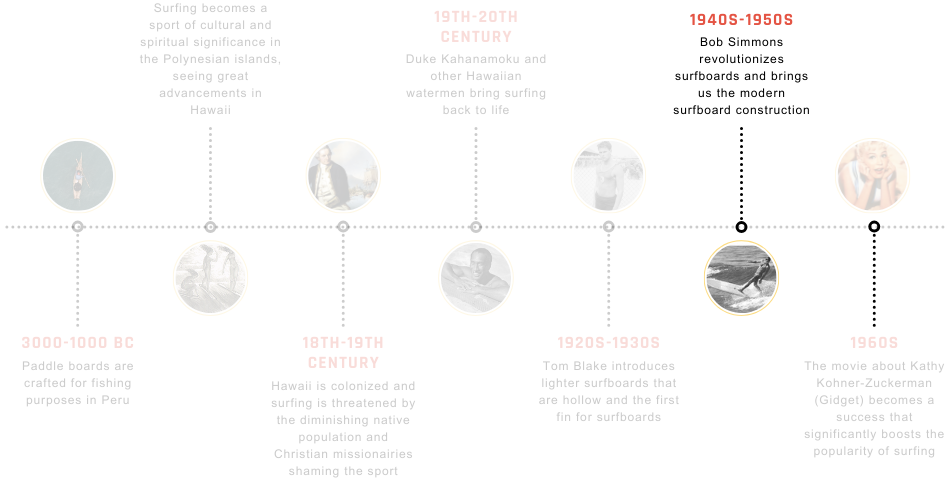
Bob Simmons was a pivotal figure in the history of surfing, known for his groundbreaking innovations in surfboard design. He was a Californian mathematician and surfer who incorporated elements of hydrodynamics and aerodynamics into surfboard designs, resulting in boards that were faster, more maneuverable, and more responsive in the water. He brought us the modern surfboard construction!
1960s: The movie about Kathy Kohner-Zuckerman (Gidget) becomes a success that significantly boosts the popularity of surfing
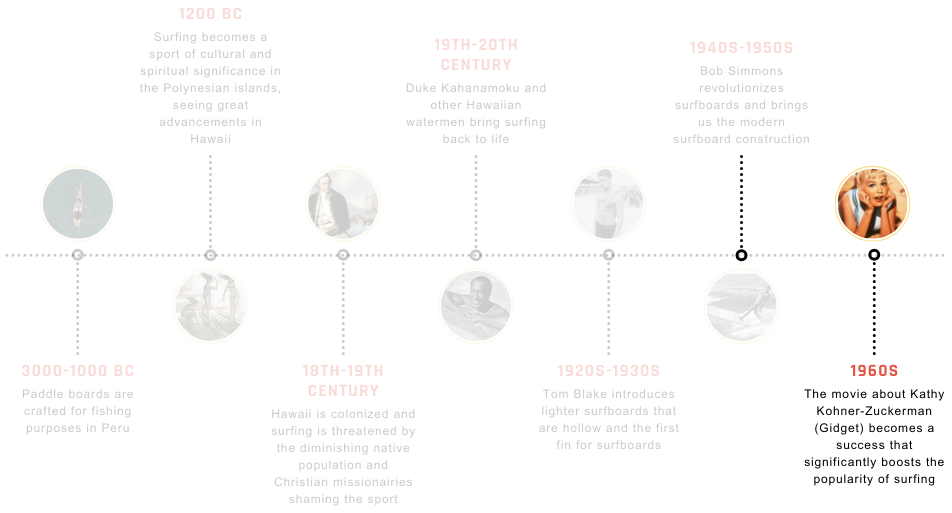
As surfboards became better and more user-friendly, surfing started growing and so did the number of women practicing surfing- Kathy Kohner-Zuckerman being one of them. Kathy lived in Malibu, California, and her dad who was a Hollywood screenwriter wrote a book about her called Gidget, that was later made into a movie released in 1959. The movie became extremely popular, and it boosted surfing’s popularity like crazy. This Hollywood movie was really what brought surfing into popular culture and inspired many women to start surfing.
Learn more about the history of surfing with Tim Jones
I very much enjoy watching Tim Jones’ Youtube videos from Surf Insight. He’s an amazing story-teller, and the way he goes into the history of surfing in this video is so captivating. One of the comments posted on the video says “I could literally envision the entire story you told beginning to end” and I couldn’t agree more. I definitely recommend you to watch it if you want to deep-dive a bit further into the history of surfing in a thrilling way.
Lesson quiz: test your knowledge

Time's up
I’d love to hear your thoughts on this post! Whether you have suggestions for improvement, want to share what you liked, or have any questions, feel free to leave a comment below. Your feedback helps me create better content for all aspiring surfers!